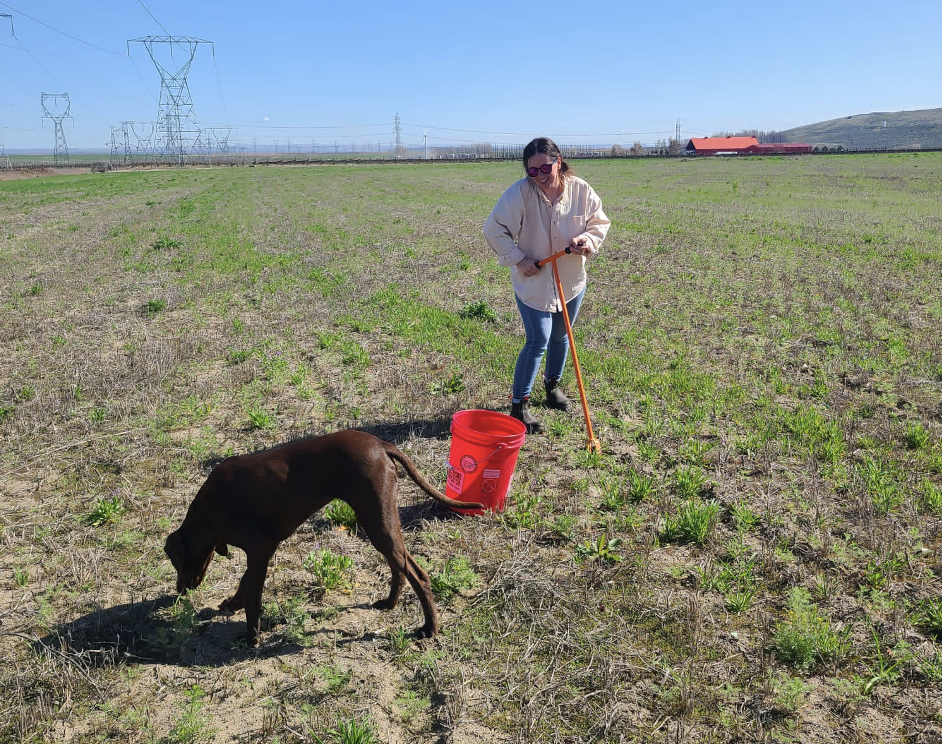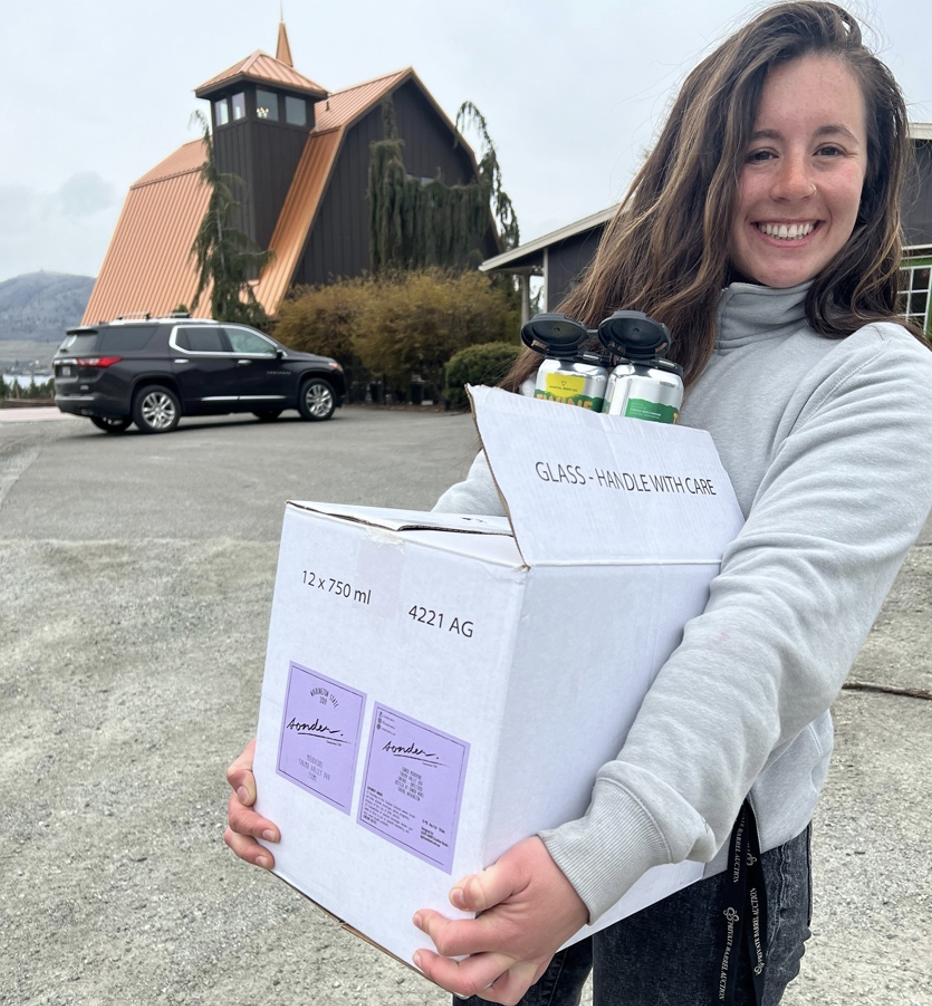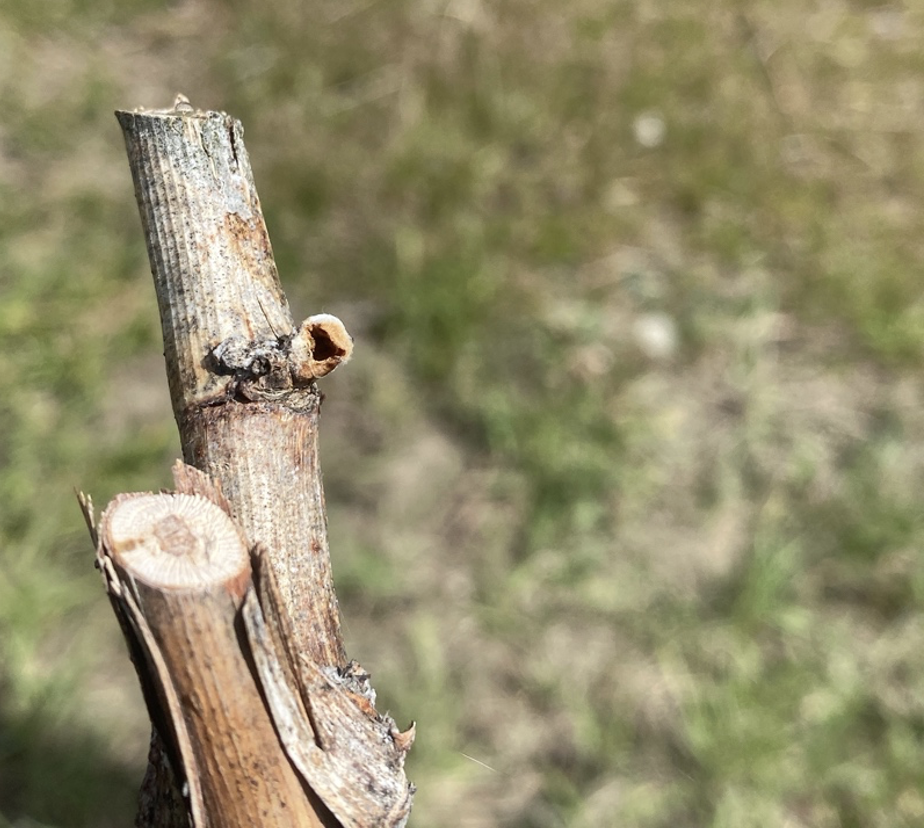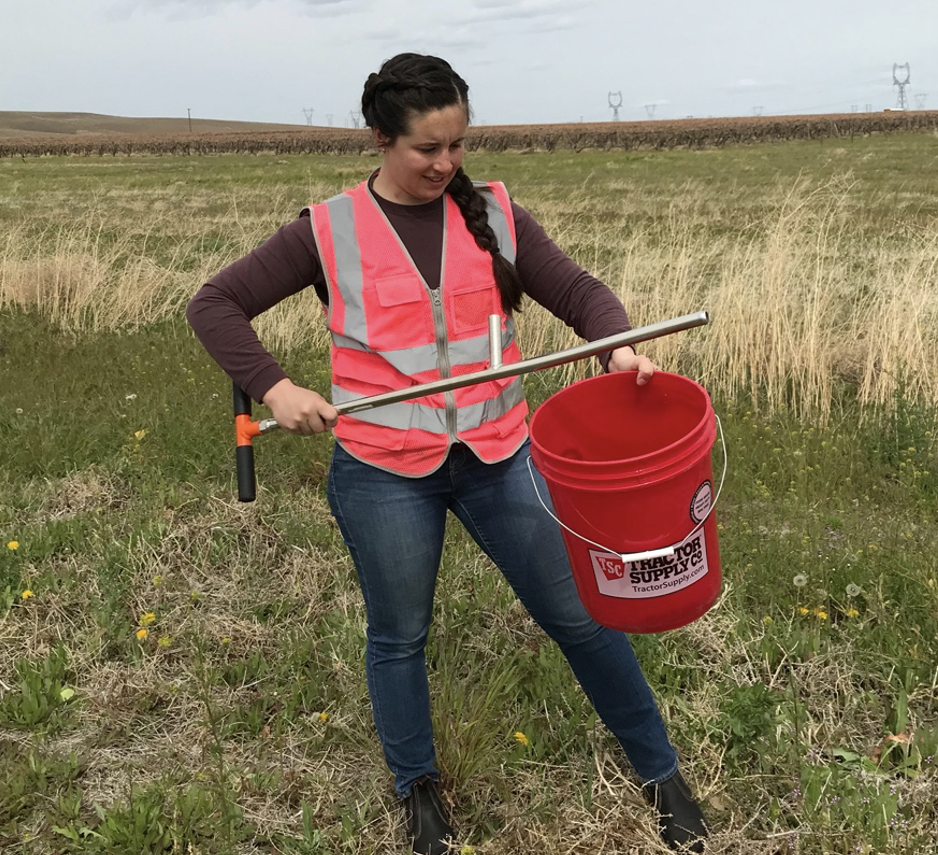Enjoy the first story from Bernadette Gagnier, WSU V&E PhD Research Student.
April, what did I do in the month of April? Usually, I am mentally preparing for May. May is when research field trials really kick off and things start to get crazy for us. So, April is when we are cleaning equipment, getting it ready for the summer and trying to organize experiments and get things set up to go full swing in a few weeks. This April we experienced more rain than I have seen since moving to Eastern Washington. We also had several nights dangerously close to freezing, with a risk for frost damage. Although I am not currently in a commercial vineyard, we have a research vineyard we rely upon for experiments and trials, and the loss of primary buds and potential foliage is always scary, but we made it through the cold nights without any frost damage.

Also in April, I went out to Chelan to help Cairdeas Winery bottle. Miriah, their enologist and I are good friends and used to be roommates. Being a researcher and not attached to one specific vineyard or winery allows me to help with different things across the industry. When the team at Cairdeas said they were going to be bottling reds, I volunteered to help. I usually help a few different places out with bottling each year. It’s not exactly fun work, but a good team makes it better, lunches are always good, and you get to be around like-minded people and usually spirits are high. It was great. The team at Cairdeas is just awesome and of course I got to hang out with my buddy for a couple days. Little moments like bottling, but great memories are part of what makes this industry so special to me

Part of my graduate research is taking soil samples in vineyard blocks that are in a period of fallow, meaning there is nothing planted in them at the time of sampling. I am trying to take samples from as many different fallow blocks as possible across the state. I am researching non-chemical ways to reduce a harmful soil-born pest called the Northern Root-knot Nematode and am hopefully that fallow ground may be a solution or part of a solution for this pest without relying on chemicals. Usually, I take soil samples in the summer, but several vineyards I had been in contact with had fallow blocks that were going to be replanted with new grapes soon. Relatively early to previous years I spent several days of April in the Horse Heaven Hills American Viticulture Area, taking soil samples that will someday result in data for an extension publication. I am used to taking these soil samples in the middle of summer, in the heat and sometimes smoke; the mild spring weather was such a nice change from the weather I am typically soil sampling in.

As our research vineyard began bud break and this year’s slow movement into shoot growth, I was doing some preliminary scouting and looking for bud break. I noticed some pretty impressive (not in a good way!) cutworm damage. Cutworms are a moth larva. They overwinter in the ground and when spring comes, they have voracious appetite and love to munch on the soft, nearly emerged buds. They chew a little hole right out of the middle of grapevine buds, eating the tender center and all the foliage and fruit contained in the little buds. I noticed their damage in the day as I was walking through our vineyard. This had never been an issue in this vineyard. I wanted to make sure it really was cutworms before we treated for its. So, I went out at night, when cutworms come out from under the bark to feed, and found them perched on the vines, devouring buds. We treated for them the next day and caught it early enough that now we are seeing plenty of foliage and clusters and we won’t lose a year of vineyard experiments and trials.
Traducido por David Rodriguez.
¿Qué hice en el mes de abril?”
“Usualmente, me estoy preparando mentalmente para Mayo”
Abril, ¿qué hice en el mes de abril? Usualmente, me estoy preparo para mayo. Mayo es cuándo la investigación de campo comienza y empezamos a enloquecer un poco. Por tanto, Abril es cuando limpiamos equipo, nos preparamos para el verano e intentamos organizar los experimentos y dejar todo preparado para ir con todo en las siguientes semanas. Este mes de abril experimentó más lluvia de la que he visto desde que me moví al este de Washington. También tuvimos varias noches en las que nos acercamos a temperaturas cercanas a heladas peligrosas. Aunque aun no estoy actualmente en un viñedo comercial, tenemos un viñedo para investigación en el cual recaemos para la experimentación de campo, y la pérdida de las yemas primarias y el potencial follaje es siempre estresante; sin embargo, pasamos las noches frías sin daño alguno.

A su vez en abril fui a Chelan a ayudar a la vinícola Cairdeas a embotellar. Miriah, su enóloga, y yo somos muy buenas amigas y solíamos ser compañeras de cuarto. Ser investigadora y no estar atada a un viñedo o vinícola específica me permite ayudar con diferentes proyectos a lo largo de la industria. Cuando el equipo de Cairdeas dijo que iban a embotellar sus vinos tintos, yo me postulé para ayudar. Usualmente ayudo a varios lugares con su embotellamiento cada año. No es exactamente trabajo agradable, pero un buen equipo lo hace todo mejor. Sin duda, las comidas siempre son buenas, y tienes oportunidad de estar alrededor de gente que piensa similar y usualmente es divertido. Fue excelente. El equipo de Cairdeas es fenomenal y por supuesto pude pasar el rato con mi amiga un par de días. Los pequeños momentos, como el fraccionado, causantes de grandes memorias son lo que hacen de esta industria algo muy especial.

Parte de mi investigación científica es tomar muestras de suelo en viñedos que están en periodo de barbecho, que significa que no hay nada plantado en el momento en que se muestrea. Estoy intentando tomar muestras de cuánto viñedo en esta condición se me presente a lo largo y ancho del estado. Estoy investigando métodos no químicos para reducir una plaga dañina de suelos llamada “Nemátodo del Nudo de la Raíz” y espero que este tipo de tierras sean una solución o parte de una solución para esta plaga sin tener que recaer en químicos. Usualmente, tomo muestras de suelo en verano, pero algunos viñedos con los que he estado en contacto tenían lotes así pero que tenían planes de replantación próximos. Relativamente temprano en años anteriores me pasaba varios días de abril en los “Horse Heaven Hills” AVA (Área Americana de Viticultura, por sus siglas en inglés), tomando muestras de suelo que en algún momento resultarían en información para una publicación. Estoy acostumbrada a tomar muestras de suelo a mediados del verano, en el calor y algunas veces hasta cuándo hay humo de incendios. Esta temporada medianamente tibia ha sido un perfecto cambio de las condiciones en las cuales estoy acostumbrada a muestrear.

Cuando nuestro viñedo de investigación comenzó la brotación y el movimiento lento de este año hacia la elongación de los pámpanos, estuve haciendo observaciones preliminares de campo y buscando brotación. Observé un problema bastante impresionante, (daño de cuncunilla). Son larvas de polilla. Pasan el invierno bajo tierra y cuándo llega la primavera, tienen un voraz apetito y les encanta la suavidad de las cuasi emergentes yemas. Mastican y hacen un hoyo en el centro del yemario de las plantas, perdiendo así todo el potencial crecimiento del año. Noté el daño un día mientras iba caminando por el viñedo. Nunca había sido problema en este viñedo específicamente, así que me quería asegurar que fuera esta plaga antes de aplicar un tratamiento. Así que salí por la noche, cuándo esta plaga sale de debajo de la corteza y las encontré pegadas a la vid comiéndose los yemarios. Por tanto, aplicamos un tratamiento específico para esta plaga y por suerte la identificamos tempranamente. Tenemos suficiente follaje y racimos y no vamos a perder un año de investigación de campo por esto.


Join the Conversation